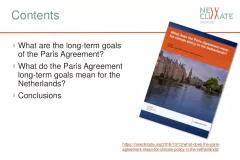The long-term global climate goals of the Paris Agreement adopted by nearly 200 countries in December 2015 imply the necessity for enhanced efforts for greenhouse gas emissions reductions in the Netherlands. The phrasing of the long term goals of the Paris Agreement goes beyond prior political consensus. The objective is to limit the global increase in temperature to “well below 2°C” above pre-industrial levels, to “pursue efforts to limit the temperature increase to 1.5°C”, as well as to lower the net GHG emissions to zero in the second half of the century. The aim of this brief analysis was to translate the goals of the international climate regime as determined by the Paris Agreement into the context of the Netherlands. Firstly, existing emissions reduction scenarios on a sectoral level (electricity, buildings, transport, etc.) were collected from existing literature, and their assumptions, methodology and results compared. Global/EU-wide scenarios and the total CO2 budget available for 1.5°C were taken as a basis for a simplified analysis on what 1.5°C would mean for enhanced actions. Conclusions on what should happen in Dutch climate policy to be in line with the Paris Agreement were drawn from the comparison of different emissions reduction scenarios.






